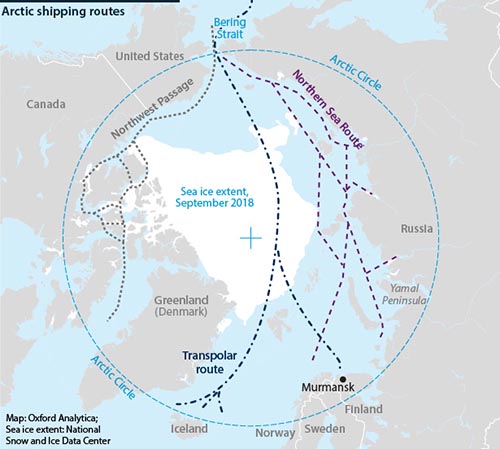[Analytics] Silk Road expands to Arctic and beyond

(Oxford Analytica Daily Brief)
During the last hours of the second annual Belt and Road Summit of April 25-27, Russian President Vladimir Putin did something very important that was missed by many onlookers. He announced the plan to connect Arctic shipping through the Northern Sea Route to China’s Maritime Silk Road, extending the already vast design for international development driven by the Belt and Road Initiative into the Arctic regions. Matthew J L Ehret specially for the Asia Times.
Putin stated on April 27: “We give major attention to the development of the Northern Sea Route [and] consider the possibility to connect it to the Chinese Maritime Silk Road.”
Weeks earlier, during the fifth International Arctic Forum on April 9-10, Putin announced that freight moving through the Northern Sea Route would increase from its current 20 million tons a year to 80 million tons by 2024. The Chinese not only participated at that major event, but also signed the first scientific treaty with Russia on April 10 establishing the China-Russia Arctic Research Center as a component of the “Polar Silk Road.” The press release stated, “Joint efforts will be made in Arctic marine science research, which will promote the construction of ‘Silk Road on Ice.’”
China’s interest in the Arctic
China, which is now putting its second icebreaker online, has recognized the importance of the Arctic flank for years, with preparations begun as far back as 1999 when China conducted its first Arctic research expedition, followed by its first scientific research station built in Norway in 2004. China then attained permanent observer status at the Arctic Council in 2011 and by 2016 created the Russia-China Polar Engineering and Research Center to develop better techniques to access Arctic resources.
Already the Power of Siberia Pipeline will supply the Chinese with the majority of their energy needs within a few years, and China has consolidated a 30% ownership stake in the Yamal LNG (liquefied natural gas) project. At the BRI Forum, the China National Oil and Gas Exploration and Development Corporation (CNODC) and China National Offshore Oil Corp (CNOOC) signed significant agreements with Russia on LNG and oil, including a 10% stake in the Arctic LNG 2 Project now being built.
With the Arctic Silk Road, not only will 10 days (5,000 nautical miles) be shaved off of shipping from China to Europe, but the overarching spirit of international development and cooperation will be linked to the Eurasian Economic Union (EEU), which comprises Russia, Belarus, Kazakhstan, Kyrgyzstan and Armenia.
Already, the EEU is finalizing its economic integration with the Belt and Road Initiative, which began in May 2015, creating a new economic bloc founded on long-term development of infrastructure. At the Belt and Road Summit, Putin said the BRI “perfectly fits into their plan” and that the members of the EEU “unanimously supported the idea of linking the construction of the Eurasian Economic Community.” As of now, China has invested US$98 billion into the real economies of the EEU involving 168 BRI-connected projects.
Bering Strait Corridor
It was in March 2015, foreseeing the Arctic extension of the Belt and Road Initiative by a number of years, that Russian Railways president Vladimir Yakunin, brilliantly called for a Trans-Eurasian Development Belt with rail stretching all the way up to the Bering Strait crossing and integrating into Asia. Yakunin, who for years has been a proponent of the connection of the Americas and Eurasia by rail, said the project should be an “inter-state, inter-civilization, project. It should be an alternative to the current (neoliberal) model, which has caused a systemic crisis. The project should be turned into a world ‘future zone,’ and it must be based on leading, not catching, technologies.” China put its support behind the Bering Strait Tunnel in May 2014.
Yakunin’s strategy perfectly encapsulated China’s methods. Chinese President Xi Jinping knows well that while it is vital to prepare for military defense, olive branches must always be offered to those threatening a war that no one would win. Niccolò Machiavelli made the point long ago that a true strategist always gives his enemies opportunities of surrender, and with the Belt and Road design that benefits all participants, this type of surrender would render everyone more prosperous. Italy has recognized this fact by recently becoming the first G7 nation to jump on board the Belt and Road, with Switzerland, Luxembourg and Greece joining close behind.
With China having called repeatedly for the US to join the BRI, and with President Donald Trump’s recent appeals for a US-Russia-China alliance on cooperation and “long-term peace,” the future looks potentially bright if nations of the West follow the Italian lead by joining in the new paradigm of cooperation.
Matthew J L Ehret is a journalist, a lecturer and founder of the Canadian Patriot Review. He is an author at the Strategic Culture Foundation, the Duran and Fort Russ. His works have been published in Executive Intelligence Review, Global Times, Los Angeles Review of Books, Veterans Today and Sott.net.